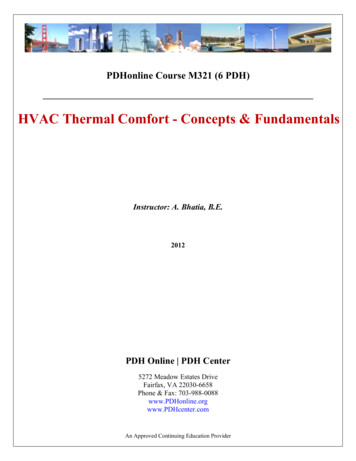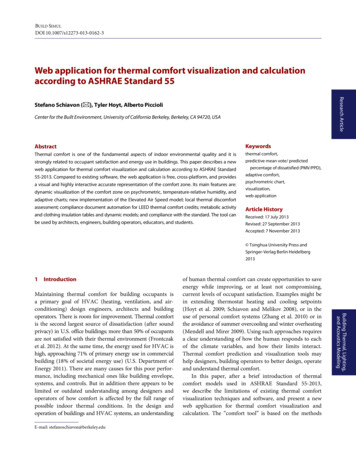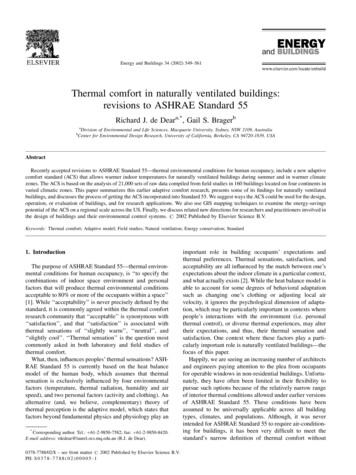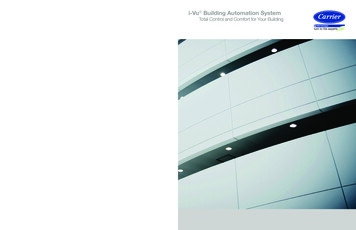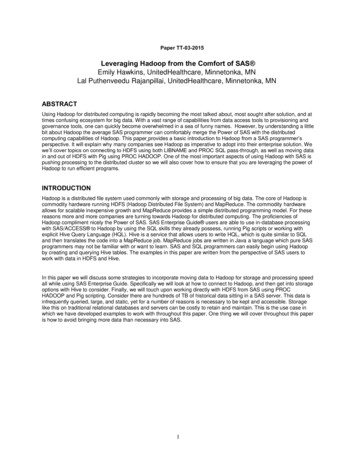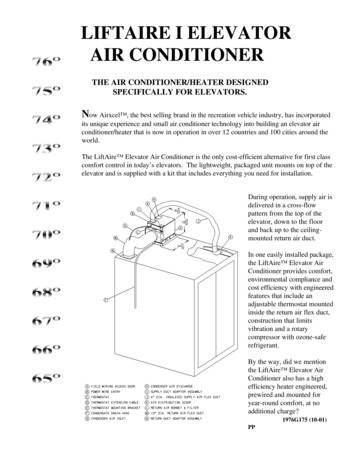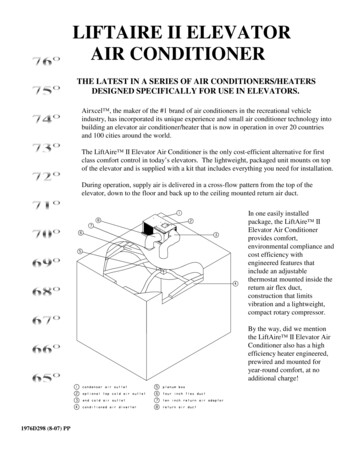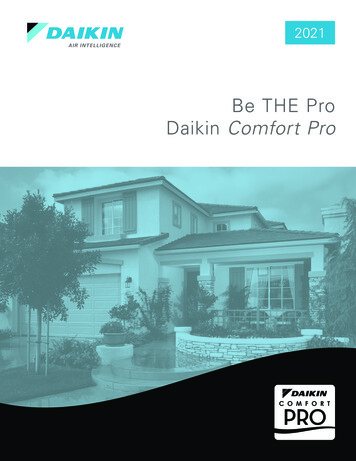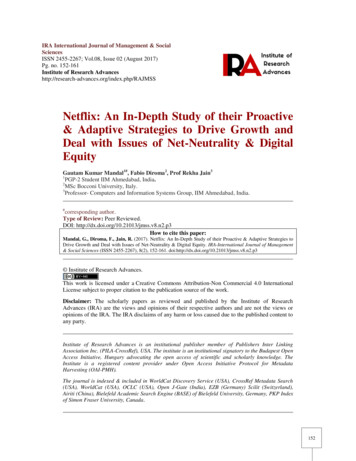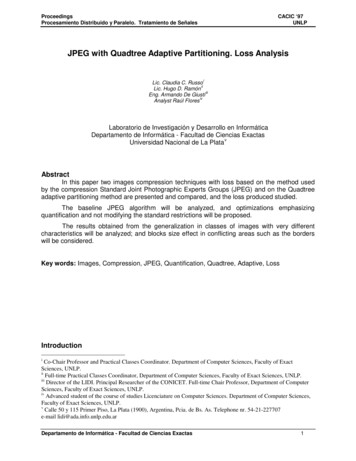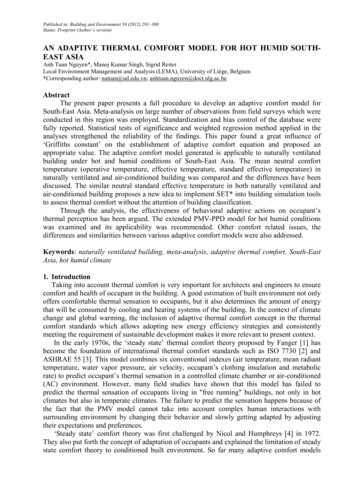
Transcription
Published in: Building and Environment 56 (2012) 291–300Status: Postprint (Author’s version)AN ADAPTIVE THERMAL COMFORT MODEL FOR HOT HUMID SOUTHEAST ASIAAnh Tuan Nguyen*, Manoj Kumar Singh, Sigrid ReiterLocal Environment Management and Analysis (LEMA), University of Liège, Belgium*Corresponding author: natuan@ud.edu.vn; anhtuan.nguyen@doct.ulg.ac.beAbstractThe present paper presents a full procedure to develop an adaptive comfort model forSouth-East Asia. Meta-analysis on large number of observations from field surveys which wereconducted in this region was employed. Standardization and bias control of the database werefully reported. Statistical tests of significance and weighted regression method applied in theanalyses strengthened the reliability of the findings. This paper found a great influence of‘Griffiths constant’ on the establishment of adaptive comfort equation and proposed anappropriate value. The adaptive comfort model generated is applicable to naturally ventilatedbuilding under hot and humid conditions of South-East Asia. The mean neutral comforttemperature (operative temperature, effective temperature, standard effective temperature) innaturally ventilated and air-conditioned building was compared and the differences have beendiscussed. The similar neutral standard effective temperature in both naturally ventilated andair-conditioned building proposes a new idea to implement SET* into building simulation toolsto assess thermal comfort without the attention of building classification.Through the analysis, the effectiveness of behavioral adaptive actions on occupant’sthermal perception has been argued. The extended PMV-PPD model for hot humid conditionswas examined and its applicability was recommended. Other comfort related issues, thedifferences and similarities between various adaptive comfort models were also addressed.Keywords: naturally ventilated building, meta-analysis, adaptive thermal comfort, South-EastAsia, hot humid climate1. IntroductionTaking into account thermal comfort is very important for architects and engineers to ensurecomfort and health of occupant in the building. A good estimation of built environment not onlyoffers comfortable thermal sensation to occupants, but it also determines the amount of energythat will be consumed by cooling and heating systems of the building. In the context of climatechange and global warming, the inclusion of adaptive thermal comfort concept in the thermalcomfort standards which allows adopting new energy efficiency strategies and consistentlymeeting the requirement of sustainable development makes it more relevant to present context.In the early 1970s, the ‘steady state’ thermal comfort theory proposed by Fanger [1] hasbecome the foundation of international thermal comfort standards such as ISO 7730 [2] andASHRAE 55 [3]. This model combines six conventional indexes (air temperature, mean radianttemperature, water vapor pressure, air velocity, occupant’s clothing insulation and metabolicrate) to predict occupant’s thermal sensation in a controlled climate chamber or air-conditioned(AC) environment. However, many field studies have shown that this model has failed topredict the thermal sensation of occupants living in "free running" buildings, not only in hotclimates but also in temperate climates. The failure to predict the sensation happens because ofthe fact that the PMV model cannot take into account complex human interactions withsurrounding environment by changing their behavior and slowly getting adapted by adjustingtheir expectations and preferences.‘Steady state’ comfort theory was first challenged by Nicol and Humphreys [4] in 1972.They also put forth the concept of adaptation of occupants and explained the limitation of steadystate comfort theory to conditioned built environment. So far many adaptive comfort models
Published in: Building and Environment 56 (2012) 291–300Status: Postprint (Author’s version)have been developed, for example adaptive model in ASHRAE 55-2004 [5] and EN15251 [6] Detailed research [7] has also pointed out that the application of adaptive comfort standard inreal building offers a huge potential in energy saving. The above saving translates toapproximately 30% of the cooling load, compared to that of a fixed temperature setpoint asindicated by conventional comfort theory.This article does not argue the validity of adaptive comfort theory since it has beencontinuously clarified during the last 2 decades. Instead, the article focuses on the developmentof an applied comfort model based on the adaptive comfort theory for hot humid South-EastAsia.Nicol [8] carried out a meta-analysis on the database of 25 comfort field surveys in hothumid climate and reported that adaptive comfort temperature in hot humid climate significantlydiffers from that in temperate and hot dry climate. South–East Asia commonly has hot andhumid climate all year round. The majority of the population almost originates from similarcultural background. They prefer to live in naturally ventilated (NV) buildings because thesocio-economic and socio-cultural preferences are optimally addressed in these buildings.Therefore, the determination of an adaptive comfort model which can be widely applied withinthis region is needed. This study describes the research methodology in detail, followed by theresults and discussions through which an adaptive comfort model for this region is generated.Other comfort related issues, the differences and similarities between various adaptive comfortmodels were also addressed in subsequent sections.2. Research methodologyThe adaptive approach for occupant’s thermal comfort relies on the analysis of the datacollected during comfort surveys conducted in the field. The researchers then use statisticalmethod to analyze the recorded data from field surveys. Since errors can rise from manysources, e.g. measuring error, data recording error or calculating error etc., a large sample isusually required for a reliable statistics. Meta- analysis [9] which combines the results of severalsurveys to address a set of related research hypotheses was applied in this research. The generalaim of a meta-analysis is to build a more powerful adaptive comfort model through a largedatabase collected from methodologically sound studies by removing the inconsistent data andalso the inconsistency between the data collected from different comfort surveys. Although thismethod has both advantages and weaknesses [10,11], it has been frequently used in otherthermal comfort researches related to data from field surveys [12,13, 14, 8].The comfort surveys selected were based on the following criteria(1) Survey locations are scattered around hot humid regions of South-East Asia (climaticboundary instead of political one);(2) Quality of the survey and subsequently the data was ensured by final researchpublication;(3) Raw data file (not only the research report or publication) created by the originalresearchers is available.Table 1 summarizes basic information of 11 comfort surveys included in this researchdatabase. All observations of gathered surveys were then transferred into a meta-file in aspreadsheet for statistical analysis. Totally 5176 sets of environmental and subjectiveobservations were included in the database (3430 records in NV building). Only 402observations of this database will be then eliminated by the data standardization. Comparingwith other surveys (e.g. European SCATs project [13] with total 4655 records – 1449 in freerunning building), this amount is considered to be sufficiently large for a reliable meta-analysis.For the purpose of statistical analysis of data in this study, the responses of all subjects oflongitudinal surveys (few subjects, sampled many times during a long period, as in case ofGuangzhou and Manila) were assumed to be independent. It means that observations oflongitudinal surveys were treated in the same manner as cross-sectional surveys. Since the
Published in: Building and Environment 56 (2012) 291–300Status: Postprint (Author’s version)earliest survey was carried out 25 years ago, we also assumed that human thermal perceptionand preference does not change over time.Table 1: Summary of the field survey database for the present VBangkokNVJakarta IndonesiaSingaporeNVJogjakarta- IndonesiaJohorBahru MalaysiaGuangzhou- kok ThailandJakarta IndonesiaManila survey1987ASHRAEClassification[12]Class 21990Class 21995Class 32001Class 22002Class 2Type ssectionalcrosssectionalcrosssectional583R. deDearJ.F. Busch39197Principlepublicationor sources[12][12]525T.H.KaryonoN. H.WongH. Feriadi375I. Hussein[17]538[12][15][16]2009Class 3Hybridcrosssectional200920101986Class 1Longitudinal921Y. Zhang[18]Class 2235Class 2R. deDearJ.F. Busch[12]19901995Class 320022003Class dinal776458277T.H.KaryonoM. M.Andamon[12][12][19]In ASHRAE RP-884 project [12], all individual responses in the database were aggregatedinto the statistical unit of each building, thus the 21000 responses were able to reduce to 160buildings. The building for which the regression analysis failed to reach statistical significance(P 0.05) was eliminated. This method has a small drawback that if the temperature range aswell as the number of respondents in a building in question are small, the linear regressionmight fall far from the real model and the mean thermal sensation vote would not reflect exactlythe thermal environment inside the building.In this study, we aggregated the large quantity of building observations into half-degree(ºC) increments, attributed by its sample size. Weighted regression was then performed to obtainthe relationship between the variables. As presented in the next sections, each scatter point inthe graph has its own weight shown by its relative area. The purpose of using a weightedregression is to minimize the impact of outlying bins which consist of small number ofobservations. This method has an advantage that the temperature range of each bin is small (0.5ºC), therefore mean thermal sensation vote closely corresponds with the thermal environment.For example, the scatter plot of Operative temperature (To) versus Thermal sensation vote(TSV) is reduced from 3430 cases in the database to about 36 weighted bins (Figure 2). Eachbin is a mean of comfort votes corresponding to a mean of half-degree (ºC) range of indoortemperature which was carefully sorted before by Excel spreadsheet. We imposed a stringentcriterion according to which only significant weighted regression (P 0.01, correlation R2 0.50) was accepted.3. Raw data standardization1Using a climate classification developed for the Macquarie University undergraduate teaching program in climatology
Published in: Building and Environment 56 (2012) 291–300Status: Postprint (Author’s version)Each comfort study included in the present database employed a specific method,although most of these studies on adaptive comfort basically relied on a relatively homogeneousmodality. Therefore, for a meta-analysis, data normalization is essential. Most informationrelated to research methodologies were obtained through the official publications or byexchanging e-mails with the original authors. This section reports in detail the data assimilationprocedure.3.1 Consistency in occupants’ clothing insulation and chair insulation effectClothing insulation is always the most troublesome in any comfort field survey because ofthe great variety of subject’s clothes. It can only be estimated precisely by using thermalmanikin. However, even in an experiment in controlled climate chamber where clothinginsulation was calculated using a sophisticated thermal manikin, the obtained insulation valuesvaried considerably between manikins [12]. In ASHRAE database, all clothing insulationestimations of the field surveys were converted using ASHRAE 55-1992 clo estimation method.Meanwhile, our newly gathered data in South-East Asia used ISO 9920-1995 [20], ASHRAE55-2004 and ASHRAE 55-1992 as clo estimation methods. As the database of this studyconsists of both sources, the consistency between these four methods must be verified. Wefound that all three methods are almost similar since they are based on the data from the worksof McCullough [21, 22] and Olesen [23, 24]. Therefore, the clo estimation method throughoutthe database was considered identical. Besides, the insulation effect of the chair of 0.1 - 0.15was consistently added into the database by the original authors.3.2 Consistency in calculated parametersThe calculated parameters consist of mean radiant temperature (Tmrt), operativetemperature (To), new effective temperature (ET*), standard effective temperature (SET*),predicted mean vote (PMV) and predicted percentage dissatisfied (PPD). These parameters werecarefully checked for consistency and recalculated wherever inconsistencies were detected. APMV-PPD calculator on Spreadsheet developed by one of the authors which allows calculationsof PMV-PPD in series was built on the code recommended by ISO 7730 [2]. ET* and SET*were calculated by the calculator of professor de Dear [25] (slightly different, but acceptableresult was yielded, compared with that given by Wincomf used in RP-884 project). Alloperative temperatures were directly recalculated by a simple equation presented in ASHRAE55-2004, based on mean radiant temperature and air temperatures plus air speed. Only for meanradiant temperature (Tmrt), we haven’t collected enough information about measuring instrumentand calculation method, therefore Tmrt given by the original authors were accepted.3.3 Gathering means of outdoor temp
ASHRAE 55 [3]. This model combines six conventional indexes (air temperature, mean radiant temperature, water vapor pressure, air velocity, occupant’s clothing insulation and metabolic rate) to predict occupant’s thermal sensation in a controlled climate chamber or air-conditioned (AC) environment. However, many field studies have shown that this model has failed to predict the thermal .
